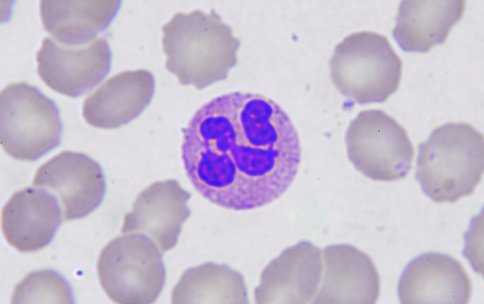
The Common Fund 4D Nucleome (4DN) program aims to discover how the shape and organization of the nuclei that house our DNA within the cells of our body control cell function and cell type. Work done by researchers within the 4DN program and other genomic scientists has explored how DNA forms loops within the nucleus and how these loops control genomic organization and regulation. Certain proteins can grab onto DNA and force it into forming large loops which can bundle together and organize the cell’s genome into regions that are activated or inactivated together and control cell health and cell type.
A 4DN research team led by Cornelis Murre made new findings on DNA loop formation while studying the nuclei of neutrophil cells. Neutrophils are a shape-shifting type of immune cell containing nuclei that also change shape as these cells develop and when they perform their functions in the body. Neutrophils fight infection and support other immune cells, and to reach damaged areas of the body they must stretch and squeeze through the walls of blood vessels and other tissues. Their nuclei must also stretch for this to be possible. Even when they are not moving through tissues, the nuclei of neutrophils look very different from most other cells: instead of a round ball shape, they have multiple lobes that can assume a variety of shapes.
Dr. Murre’s team found that neutrophil nuclei aren’t shaped by the same processes of loop formation like other cells, but instead depend on there being no loop formation. The team found that neutrophils have lower amounts of the proteins that guide DNA to form loops. Non-mature immune cells have round nuclei like in most other cells and DNA loop-forming proteins. When the scientists took these cells from mice and removed their loop-forming proteins, the cells transformed into neutrophils with multi-lobed nuclei. As the shape of the nuclei changed, regions of DNA within the cell nuclei came closer to or further from each other, causing different genes to be activated or turned off. This established the cellular type of a mature neutrophil capable of changing shape and squeezing through tissues to fight infection. These new findings on non-conventional DNA organization in shape-changing cells may provide biological insights into other cells that migrate through tissues during injury or how changes in nuclear shape can contribute to diseases like cancer.
Reference: Patta I, Zand M, Lee L, Mishra S, Bortnick A, Lu H, Prusty A, McArdle S, Mikulski Z, Wang HY, Cheng CS, Fisch KM, Hu M, Murre C. Nuclear morphology is shaped by loop-extrusion programs. Nature. 2024 Mar;627(8002):196-203. doi: 10.1038/s41586-024-07086-9.


